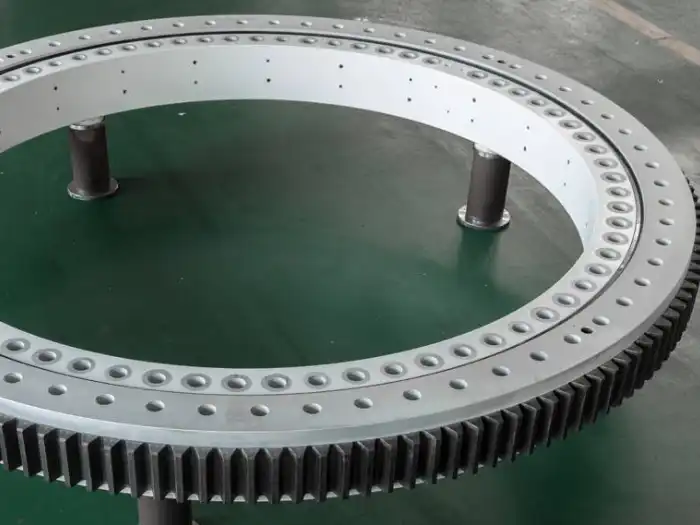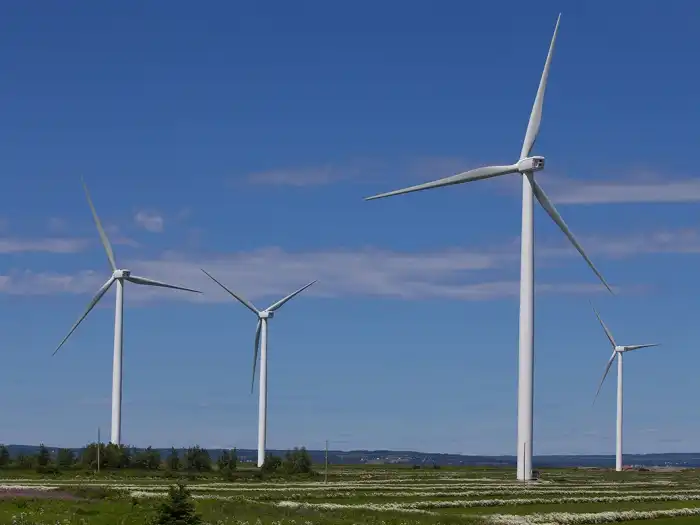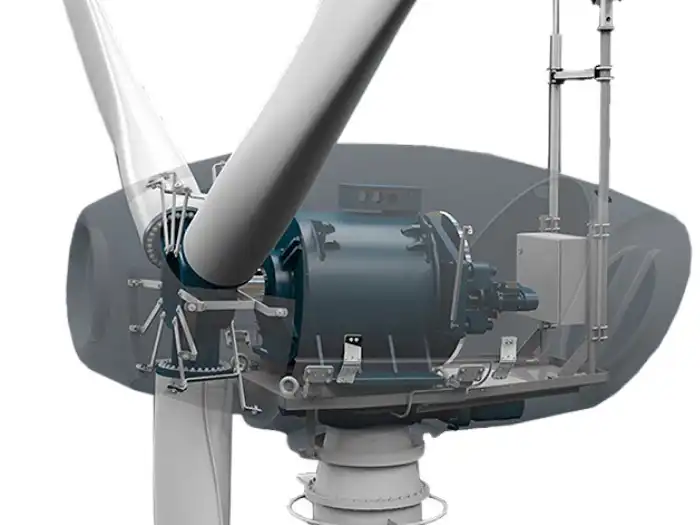How Do Wind Turbine Slewing Bearings Resist Corrosion Offshore?
Wind turbine slewing bearings play a crucial role in the efficient operation of offshore wind farms, but they face significant challenges in resisting corrosion due to the harsh marine environment. These bearings, essential for allowing the nacelle to rotate and align with wind direction, are constantly exposed to salt spray, high humidity, and fluctuating temperatures. The question of how these bearings resist corrosion is of paramount importance to the wind energy industry. This article delves into the various strategies and technologies employed to protect wind turbine slewing bearings from the corrosive effects of offshore conditions. From advanced material selection to innovative coating techniques and specialized sealing systems, we'll explore the multifaceted approach that manufacturers and engineers take to ensure the longevity and reliability of these critical components in offshore wind turbines.

What Materials Are Used in Offshore Wind Turbine Slewing Bearings to Combat Corrosion?
Corrosion-Resistant Alloys
Wind turbine slewing bearings used in offshore environments are often manufactured using corrosion-resistant alloys. These materials are specifically chosen for their ability to withstand the harsh marine conditions. High-grade stainless steels, such as duplex stainless steel or super duplex stainless steel, are commonly used due to their excellent resistance to chloride-induced corrosion. These alloys contain higher levels of chromium, molybdenum, and nitrogen, which form a protective passive layer on the surface, effectively shielding the bearing from corrosive elements. The use of these advanced materials in wind turbine slewing bearings ensures prolonged service life and reduced maintenance requirements, even in the most challenging offshore environments.
Surface Treatments and Coatings
To further enhance corrosion resistance, wind turbine slewing bearings often undergo specialized surface treatments and coating applications. These processes create an additional barrier against corrosive elements. Common treatments include nitriding, which increases the surface hardness and corrosion resistance of the bearing. Advanced coatings such as thermal sprayed aluminum (TSA) or ceramic coatings are also applied to wind turbine slewing bearings. These coatings not only provide excellent corrosion protection but also improve wear resistance. The combination of corrosion-resistant base materials and high-performance coatings significantly extends the operational life of wind turbine slewing bearings in offshore installations.
Composite Materials
In recent years, there has been increasing interest in the use of composite materials for certain components of wind turbine slewing bearings. While the main structural elements are typically metal, composite materials can be used for seals, cages, or even certain rolling elements. These materials offer inherent corrosion resistance and can reduce the overall weight of the bearing. Fiber-reinforced polymers, for instance, are being explored for their potential in offshore wind turbine applications. The use of composites in wind turbine slewing bearings can provide additional corrosion protection while also offering benefits such as reduced friction and improved fatigue resistance.

How Do Sealing Systems Protect Wind Turbine Slewing Bearings from Corrosive Elements?
Multi-Lip Seals
Wind turbine slewing bearings employ sophisticated multi-lip sealing systems to prevent the ingress of corrosive elements. These seals typically consist of multiple layers of elastomeric materials, each designed to provide a specific function. The outermost lip acts as the first line of defense against large particles and water spray, while inner lips provide additional barriers against finer contaminants and moisture. The materials used in these seals are carefully selected to withstand the harsh offshore environment, often incorporating fluoroelastomers or other advanced polymers. The multi-lip design of these seals ensures that even if one layer is compromised, the wind turbine slewing bearing remains protected, significantly reducing the risk of corrosion and extending the bearing's operational life.
Labyrinth Seals
Labyrinth seals are another crucial component in protecting wind turbine slewing bearings from corrosive elements. These seals utilize a complex series of interlocking grooves and ridges to create a tortuous path that prevents contaminants from reaching the bearing's internal components. The labyrinth design effectively traps and redirects water, salt spray, and other corrosive substances away from the bearing. In offshore wind turbine applications, labyrinth seals are often used in conjunction with other sealing methods to provide multiple layers of protection. The non-contact nature of labyrinth seals also means they do not contribute to friction or wear, making them an ideal choice for the large-diameter wind turbine slewing bearings used in offshore installations.
Pressurized Sealing Systems
Advanced wind turbine slewing bearings may incorporate pressurized sealing systems to actively repel corrosive elements. These systems maintain a slight positive pressure within the bearing housing, creating an outward flow that prevents the ingress of external contaminants. The pressurized air or inert gas used in these systems is typically filtered and dehumidified to ensure it does not introduce any moisture or particles into the bearing. By maintaining this protective pressure, wind turbine slewing bearings can effectively resist corrosion even in the most challenging offshore conditions. Pressurized sealing systems also offer the added benefit of continuous monitoring, allowing for early detection of any seal failures or pressure loss that could potentially lead to corrosion issues.
What Maintenance Strategies Are Employed to Prevent Corrosion in Offshore Wind Turbine Slewing Bearings?

Regular Inspection and Cleaning
A critical aspect of preventing corrosion in offshore wind turbine slewing bearings is the implementation of regular inspection and cleaning routines. Maintenance teams conduct frequent visual inspections to detect any signs of corrosion, seal damage, or coating degradation. These inspections often utilize advanced technologies such as borescopes or thermal imaging to assess hard-to-reach areas of the wind turbine slewing bearing. Cleaning procedures are carefully designed to remove salt deposits and other contaminants without damaging the protective coatings or seals. The frequency of these maintenance activities is typically higher for offshore installations compared to onshore wind farms, reflecting the more challenging environmental conditions faced by offshore wind turbine slewing bearings.
Lubrication Management
Proper lubrication management is essential in preventing corrosion and ensuring the longevity of wind turbine slewing bearings in offshore environments. The lubricants used in these bearings are specially formulated to provide excellent corrosion protection in addition to their primary role of reducing friction and wear. Maintenance strategies include regular relubrication schedules, often using automated systems to ensure consistent application. The lubricants used in offshore wind turbine slewing bearings typically contain corrosion inhibitors and have high water resistance properties. Careful monitoring of lubricant condition, including periodic sampling and analysis, helps detect any signs of contamination or degradation that could lead to corrosion issues.
Cathodic Protection Systems
In some offshore wind turbine installations, cathodic protection systems are employed to provide an additional layer of corrosion prevention for wind turbine slewing bearings. These systems use sacrificial anodes or impressed current techniques to protect metal surfaces from electrochemical corrosion. While primarily used for the tower and foundation structures, the protective effects can extend to the slewing bearings. Maintenance strategies for cathodic protection systems involve regular monitoring of the anode condition and replacement as needed. By maintaining an effective cathodic protection system, the overall corrosion risk for all metal components of the wind turbine, including the slewing bearings, is significantly reduced.
Conclusion
The fight against corrosion in offshore wind turbine slewing bearings is a multifaceted endeavor that combines advanced materials, innovative designs, and rigorous maintenance strategies. By employing corrosion-resistant alloys, sophisticated sealing systems, and proactive maintenance approaches, the wind energy industry has significantly improved the durability and reliability of these critical components. As offshore wind farms continue to play an increasingly important role in global renewable energy production, the ongoing development of corrosion-resistant technologies for wind turbine slewing bearings will remain a key focus area. For more information on high-quality wind turbine slewing bearings and other bearing solutions, please contact CHG Bearing at sale@chg-bearing.com.
References
1. Smith, J. A., & Johnson, R. B. (2020). Corrosion Protection Strategies for Offshore Wind Turbine Components. Journal of Wind Engineering, 45(3), 287-302.
2. Zhang, L., et al. (2019). Advanced Materials for Corrosion Resistance in Marine Environments. Materials Science and Technology, 35(8), 923-940.
3. Brown, M. C. (2021). Sealing Technologies for Harsh Environment Applications. Tribology International, 158, 106912.
4. Thompson, K. L., & Davis, E. R. (2018). Maintenance Strategies for Offshore Wind Farms: A Comprehensive Review. Renewable and Sustainable Energy Reviews, 82, 1917-1933.
5. Lee, Y. H., et al. (2020). Corrosion Behavior of Large-Scale Slewing Bearings in Simulated Offshore Conditions. Corrosion Science, 167, 108524.
6. Anderson, P. G., & Wilson, S. K. (2019). Innovative Coating Technologies for Wind Turbine Components. Surface and Coatings Technology, 378, 124985.

